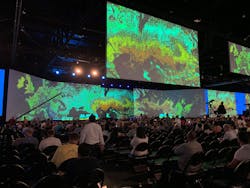ESRI User Conference Kicks Off; Collaboration with Jane Goodall Institute Announced
Today kicks off the 39th Annual ESRI User Conference in San Diego, California. Jane Goodall, Jack Dangermond and renowned conservationist E.O. Wilson gave the the opening keynote of the conference. They certainly did not disappoint. They discussed what they have learned over their legendary careers helping to protect species and ecosystems, as well as the role GIS technology plays in the future of global biodiversity.
ESRI also announced a partnership with the Jane Goodall Institute to develop a set of tools that will help communities map and manage the ecosystems around them through a collaborative design and planning approach, aided by GIS software. These tools will help communities map, monitor, and better manage their natural resources from community forests and wildlife reserves, to water catchment and flood control areas, as well as human settlement, agriculture, and agroforestry spaces.
“Conservation at the community level is essential to sustaining our natural world,” said Jack Dangermond, ESRI founder and president. “Protecting global ecosystems cannot work on a global scale unless it starts locally, which is why we are honored to work with our friend and partner, the Jane Goodall Institute, on this collaboration, leveraging their years of experience working at the local scale in pursuit of conservation, balanced with the needs of human communities.”
“We adopt and put in the hands of local communities the best available technologies and tools relevant to support conservation in practice,” continued Dr. Goodall. “The geospatial technologies that ESRI provides will enable us to scale up our projects so that we cover hundreds of villages, ensuring that information is actionable and relevant to decision-makers to help design and manage landscapes that better support people’s livelihoods, as well as wildlife.”
GIS technology enables many electric utility use cases including: line inspections, underground damage prevention, wildfire prediction, disaster recovery, navigating protected ecosystems and more. The use of GIS technology also helps to inform our understanding of climate change and enhances the ability of utilities to responsibly and collaboratively provide life sustaining electric service to our communities; this is most certainly beneficial for us all. We applaud the leadership of ESRI and the Jane Goodall Institute in this endeavor.
About the Author
Martha Davis
Senior Director of Content
Prior to working at T&D World and Utility Analytics Institute, Martha worked as an executive in the energy industry for about 15 years. She has held various regulatory and government affairs positions and had the opportunity to shape public policy.
Martha has a B.A. from Westminster College in Fulton, MO; completed specialized legal and public policy coursework at American University in Washington, D.C.; M.P.A. Public Affairs and M.B.A. Business Administration both from the University of Missouri. She is currently a doctoral candidate at the University of Denver where she is researching business analytics, innovation and regulation.
